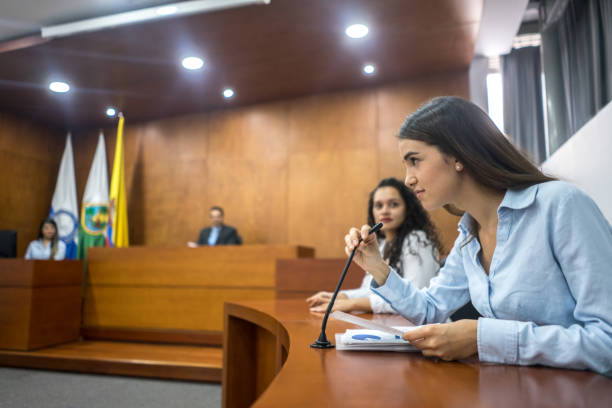From Idea to Court: Actions to Create Powerful and Convincing Trial Presentations
From Idea to Court: Actions to Create Powerful and Convincing Trial Presentations
Blog Article
Navigating the Intricacies of Trial Presentations: Tips for Seamless Distribution and Compelling Debates
In the realm of legal procedures, the art of trial presentation stands as an essential component of success. The complexities inherent in trial presentations require a delicate equilibrium of skill, skill, and method.

Understanding Trial Goals
To effectively navigate a trial, it is important to have a clear understanding of the purposes that require to be attained. Prior to stepping into the courtroom, legal teams should define their objectives and preferred end results. These purposes function as guiding principles throughout the trial, shaping strategies and influencing decision-making processes.
Comprehending test goals includes a detailed evaluation of the instance, lawful criteria, and the client's benefits. Trial Presentations. It calls for a careful evaluation of the truths, determining vital issues, and expecting prospective challenges. By establishing particular and quantifiable objectives, attorneys can customize their arguments and presentations to line up with the wanted outcomes
Furthermore, a clear grasp of test objectives allows lawful teams to prioritize evidence, witnesses, and lawful debates effectively. It enables the growth of a meaningful narrative that reverberates with the discretionary, reinforcing the general case discussion.

Organizing Evidence Properly
Having a clear understanding of trial purposes lays the foundation for arranging evidence properly in legal process. By lining up the discussion of proof with the desired results of the trial, lawful teams can enhance their disagreements and enhance their persuasiveness.
One more crucial element in arranging evidence properly is establishing a sensible flow. Providing proof in a sequential and meaningful fashion can help develop an engaging narrative that sustains the lawful arguments being made. In addition, using visual help such as timelines, charts, or graphes can further improve the company of evidence and help in clearing up intricate relationships or sequences of occasions.
Furthermore, guaranteeing that all proof offered is admissible and pertinent to the situation is essential. Inadmissible or pointless proof can detract from the strength of the disagreement and potentially hurt the integrity of the presenting celebration. A thorough testimonial and option process should be carried out to include only the most legally sound and impactful proof in the test presentation.
Crafting Influential Narratives
Crafting engaging narratives plays a pivotal function in presenting influential arguments throughout legal process. When building a story for a trial discussion, it is important to develop a clear storyline that highlights vital points and attaches them in a coherent fashion. By weaving together evidence, testament, and legal debates into a convincing and natural narrative, legal specialists can efficiently support for their clients and enhance the chance of a beneficial end result in the courtroom.
Grasping Aesthetic Aids
Efficient usage of aesthetic help is essential to improving the influence and clarity of trial discussions. Aesthetic help, when utilized tactically, have the power to streamline intricate information, strengthen crucial factors, and leave a lasting impression on the discretionary. To understand aesthetic help in test presentations, it is important to make sure resource that they are clear, succinct, and pertinent to the arguments being made.
When incorporating visual aids, such as charts, pictures, timelines, or charts, right into a test discussion, it is important to maintain them aesthetically appealing yet professional. The visuals should complement the spoken arguments, providing an aesthetic depiction of the details being reviewed without frustrating the target market with unneeded information.
Additionally, exercising with the visual aids beforehand is vital to make sure a seamless delivery during the test. Acquainting oneself with the material, shifts, and timings of each visual aid can aid keep the circulation of the presentation and avoid technical problems that might occur.
Delivering Impactful Closing Arguments
An engaging closing debate works as the culmination of a test discussion, encapsulating the core story and encouraging the discretionary in the direction of a positive decision. To deliver an impactful basics closing debate, it is important to succinctly wrap up key factors, highlight the staminas of your case, and attend to any type of weaknesses in a calculated manner. Begin by laying out the primary arguments that this hyperlink sustain your client's placement, highlighting why the evidence presented throughout the test sustains your narrative. It is vital to create a feeling of communication and clarity, assisting the court and jury in the direction of the wanted conclusion.
Moreover, incorporating emotional charm can additionally enhance your closing debate. Inevitably, a well-crafted closing debate need to leave a lasting impression, compelling the judge and court to rule in your customer's support.
Verdict
In verdict, understanding test discussions entails recognizing purposes, arranging proof, crafting narratives, using visual aids, and delivering impactful closing arguments. By implementing these strategies properly, legal representatives can offer their instance effortlessly and make compelling arguments in the courtroom. It is essential to browse the intricacies of test presentations with precision and skill to achieve success in lawful process.
By lining up the presentation of evidence with the wanted results of the trial, lawful groups can enhance their arguments and boost their persuasiveness (Trial Presentations). To grasp visual help in trial discussions, it is critical to make sure that they are clear, concise, and relevant to the debates being made
A compelling closing argument offers as the conclusion of a test discussion, encapsulating the core story and convincing the court and jury towards a desirable decision. Begin by laying out the primary arguments that sustain your client's placement, highlighting why the proof provided throughout the test supports your story.In final thought, understanding trial discussions includes recognizing goals, arranging evidence, crafting stories, utilizing aesthetic aids, and providing impactful closing arguments.
Report this page